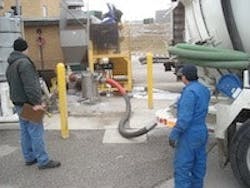West Lafayette Plant Gets a Grip on Grease Management
Grease can cause big problems, but when managed properly it can provide big dividends as a renewable energy source. The wastewater treatment plant in West Lafayette, Ind., has grease in abundance and is making the most of it.
In 2012, the plant received an average of 18,000 gal of grease per month. Although grease deliveries are not always daily, the plant can get multiple deliveries in one day. One small tanker truck can bring in 2,000 to 3,000 gal while a large truck can bring in between 4,000 to 5,000 gal.
An Abundance of Grease
When the West Lafayette treatment plant implemented a major upgrade in 2009, operators installed two microturbines for generating electricity to make use of the methane produced in their digesters. At the same time, they also installed a grease receiving station. This station conveys grease to the digesters to produce even more methane for the microturbines.
“The initial grease receiving station we installed utilized a septage receiving trap that just couldn’t handle the debris,” said Jim Bjork, maintenance supervisor for the West Lafayette wastewater treatment utility.
The incoming grease varied widely in consistency. Thick grease prevented debris-heavy metallic objects from settling in the metal trap. Thin consistency grease, on the other hand, would allow most of the debris to flow into the grease tank. Since there was no grinder on the discharge side of this trap, debris entering the grease tank would get pulled into the metering pump, often causing blockage and severe damage, and would require expensive repair to the pump.
Solving the Problem
The plant installed JWC Environmental’s (JWCE) Heavy Object Trap (HOT) in 2011. The HOT (model GRS) features an adjustable bar screen with 0.5-in. spacings. As grease trucks unload, all debris is captured by the screen. The liquid grease, unhindered by any solid objects, then flows smoothly downstream, without process disruption.
The HOT is available in six sizes and features an adjustable bar screen with 0.5- or 1-in. spacings, so site operators can change the capture rate of debris. As grease trucks unload, rocks, rags, knives, plastics and other debris are captured. In many installations a Muffin Monster grinder then homogenizes the liquid grease, breaking clumps into an easy-to-pump slurry.
“The JWCE HOT has significantly reduced the amount of debris being discharged into our grease tank,” Bjork said. “The unit’s bar racks stop rags and lighter debris that flow easily, while the unit’s basket catches heavier debris.”
Because it is easy to clean the HOT, operators open it frequently to check it, and if needed, clean it before a second truck comes in to offload. They also run hot water through the unit, which rinses most of the grease out of the basket while retaining the solids.
“Our return on investment has been excellent,” says Bjork. “We now have much better grease screening, which means the grease metering pump sustains much less wear and tear.”
The West Lafayette treatment plant also uses a large Macho Monster shredder to homogenize food waste that is brought into the facility from Purdue University’s large cafeterias. The food waste is ground up and pumped into the sludge digesters to also boost biogas production.
Cynthia Guardia is president of CIA Communications. For more information, contact JWC Environmental at [email protected] or 800.331.2277.
